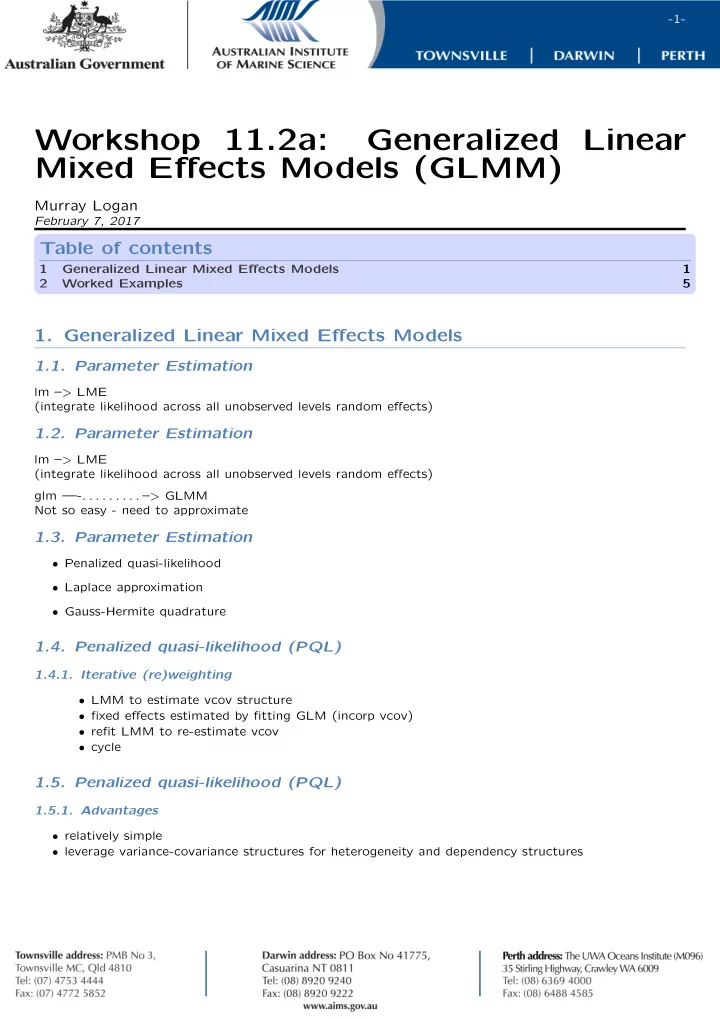

-1- Workshop 11.2a: Generalized Linear Mixed Effects Models (GLMM) Murray Logan February 7, 2017 Table of contents 1 Generalized Linear Mixed Effects Models 1 2 Worked Examples 5 1. Generalized Linear Mixed Effects Models 1.1. Parameter Estimation lm –> LME (integrate likelihood across all unobserved levels random effects) 1.2. Parameter Estimation lm –> LME (integrate likelihood across all unobserved levels random effects) glm —-. . . . . . . . . –> GLMM Not so easy - need to approximate 1.3. Parameter Estimation • Penalized quasi-likelihood • Laplace approximation • Gauss-Hermite quadrature 1.4. Penalized quasi-likelihood (PQL) 1.4.1. Iterative (re)weighting • LMM to estimate vcov structure • fixed effects estimated by fitting GLM (incorp vcov) • refit LMM to re-estimate vcov • cycle 1.5. Penalized quasi-likelihood (PQL) 1.5.1. Advantages • relatively simple • leverage variance-covariance structures for heterogeneity and dependency structures
-2- 1.5.2. Disadvantages • biased when expected values less <5 • approximates likelihood (no AIC or LTR) 1.6. Laplace approximation Second-order Taylor series expansion - to approximate likelihood at unobserved levels of random effects 1.7. Laplace approximation Second-order Taylor series expansion - to approximate likelihood at unobserved levels of random effects 1.7.1. Advantages • more accurate 1.8. Laplace approximation Second-order Taylor series expansion - to approximate likelihood at unobserved levels of random effects 1.8.1. Advantages • more accurate 1.8.2. Disadvantages • slower • no way to incorporate vcov 1.9. Gauss-Hermite quadrature (GHQ) • approximates value of integrals at specific points (quadratures) • points (and weights) selected by optimizer 1.10. Gauss-Hermite quadrature (GHQ) • approximates value of integrals at specific points (quadratures) • points (and weights) selected by optimizer 1.10.1. Advantages • even more accurate 1.11. Gauss-Hermite quadrature (GHQ) • approximates value of integrals at specific points (quadratures) • points (and weights) selected by optimizer 1.11.1. Advantages • even more accurate 1.11.2. Disadvantages • even slower • no way to incorporate vcov
-3- 1.12. Markov Chain Monte Carlo (MCMC) • recreate likelihood by sampling proportionally to likelihood 1.13. Markov Chain Monte Carlo (MCMC) • recreate likelihood by sampling proportionally to likelihood 1.13.1. Advantages • very accurate (not an approximation) • very robust 1.14. Markov Chain Monte Carlo (MCMC) • recreate likelihood by sampling proportionally to likelihood 1.14.1. Advantages • very accurate (not an approximation) • very robust 1.14.2. Disadvantages • very slow • currently complex 1.15. Inference (hypothesis) testing 1.15.1. GLMM Depends on: • Estimation engine (PQL, Laplace, GHQ) • Overdispersed • Fixed or random factors 1.16. Inference (hypothesis) testing Approximation Characteristics Associated inference R Function Penalized Quasi- Fast and simple, accommodates heterogene- Wald tests only glmmPQL (MASS) likelihood (PQL) ity and dependency structures, biased for small samples Laplace More accurate (less biased), slower, does not LRT glmer (lme4), glmmadmb accommodate heterogeneity and dependency (glmmADMB) structures Gauss-Hermite Evan more accurate (less biased), slower, LRT glmer (lme4)?? - does quadrature does not accommodate heterogeneity and not seem to work dependency structures, cant handle more than 1 random effect Markov Chain Bayesian, very flexible and accurate, yet very Bayesian credibility intervals, Bayes factors Numerous (see Tuto- Monte Carlo slow and more complex rial 9.2b) (MCMC)
. . Zero-inflation glmmPQL(.., family='negative.binomial') Clumpiness glmmPQL(.., family='quasi..') Yes glmmPQL() No Inference Model Overdispersed . PQL . . Data normalizable (via transformations) . yes yes . . Normally distributed data . Random effects . lm (), gls() . no glmmadmb(.., zeroInflated=TRUE) yes lme() Clumpiness 1 yes . no . no . no . glmmadmb(.., zeroInflated=TRUE) Zero-inflation glmmamd(.., family='nbinom') glmer(.., family='negative.binomial') glmer(..(1|Obs)) . Yes glmer() or glmmadmb() No Fixed effects LRT (ML) glmer() or glmmadmb() Yes or no Random effects Inference Model Overdispersed . Laplace or GHQ . -4- Feature glmmQPL (MASS) glmer (lme4) glmmadmb (glmmADMB) MCMC Varoamce amd covariance structures Yes - not yet Yes Overdispersed (Quasi) families Yes limited some - Mixture families limited limited limited Yes Zero-inflation - - Yes Yes Residual degrees of freedom Between-within -* - NA Parameter tests Wald t Wald Z Wald Z UI Wald F , χ 2 Wald F , χ 2 Wald F , χ 2 Marginal tests (fixed effects) UI Wald F , χ 2 Marginal tests (random effects) LRT LRT UI Information criterion - AIC AIC AIC, WAIC 1.17. Inference (hypothesis) testing 1.18. Inference (hypothesis) testing Expected value > 5 Wald Z or χ 2 Wald t or F Wald t or F Wald t or F Wald Z or χ 2 Wald t or F Wald t or F Wald t or F Wald t or F 1.19. Additional assumptions • dispersion • (multi)collinearity • design balance and Type III (marginal) SS • heteroscadacity • spatial/temporal autocorrelation
-5- 2. Worked Examples 2.1. Worked Examples log ( yij ) = γ Sitei + β 0 + β 1 Treati + ε ij ε ∼ Pois ( λ ) ∑ where γ = 0
Recommend
More recommend